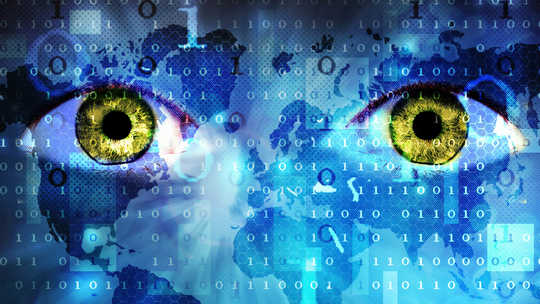
They can shape public sentiment on everything from climate change to public health. Understanding why people believe them is vital, researchers say.
Did you hear about how the recent California wildfires were set intentionally? From an airplane? With a laser? To clear a path for a railroad? While your cousin may have obtained his information from some guys at the gym, this idea can also be found on social media, along with other theories about the California fires.
YouTube videos claim that the October 2017 wildfires that swept through Northern California were the result of a government attack or a weapons test using some kind of laser or microwave device. The evidence, they say, is in houses that burned flat while trees around them were left standing. “It doesn’t make any sense,” says one YouTuber, over footage of the rubble.
It does make sense, though, to Jack Cohen. A retired research physical scientist for the U.S. Forest Service who has studied fires both in the field and in the lab, Cohen calls this burn pattern typical. A wildfire, he says, actually burns less intensely when it reaches a neighborhood. Instead of sweeping forward as a wall of flame, it becomes sneaky, hopping between wooden houses and dry patches of lawn via embers.
The alleged railway path doesn’t hold up to scrutiny, either. But fact-checking probably won’t stop some from seeing insidious patterns in fires and other natural disasters. Of course, climate change is helping to make these events more frequent and intense, but to the conspiracy-minded, climate change itself is a hoax.
Researchers have defined conspiracy theories as “explanatory beliefs about a group of actors that collude in secret to reach malevolent goals.” These theories can feel like they’re everywhere right now, from Facebook to Twitter to the Thanksgiving table, though research suggests that this is not unique to today. In fact, conspiracy theories have been more common in previous moments in history, experts say. Still, in the modern era, when conspiracy theories hold the power to shape beliefs on everything from climate change, to politics, to public health, it may be especially important to understand why some people believe what they do.
Conspiracy theory research has grown dramatically in the last decade, says Karen Douglas, a social psychologist at the University of Kent in the U.K. In a 2017 paper, Douglas and co-author Jan-Willem van Prooijen explored a link between conspiracy theories and societal crises. They went all the way back to another fire — the burning of Rome in 64 A.D., which happened while Emperor Nero was safely away from the city.
In the widespread destruction afterward, conspiracy theorists suggested Nero had started the fire on purpose so he could rebuild Rome the way he wanted.
In turn, Nero claimed Christians had conspired to burn the city.
In the 2014 book “American Conspiracy Theories,” Joseph Uscinski, a political scientist at the University of Miami who specializes in conspiracy theories, along with co-author Joseph Parent, set out to quantify conspiracy theories over time. The authors gathered 120 years’ worth of letters to the editor of The New York Times, ending up with more than 100,000. By scouring this mountain of correspondence for mentions of conspiracy theories, Uscinski and Parent were able to see trends over time.
Between 1890 and 2010, they found two peaks. These were at times when the public, Republicans and Democrats alike, feared a common enemy, Uscinski says: the early 1890s, when people feared big businesses, and the early 1950s, when the enemy was communism. Leading up to the end of their dataset, though, the authors saw mentions of conspiracy theories drop off. “It’s impossible to measure the exact amount that there are out there in the political ether,” Uscinski says. But he doesn’t see any strong evidence that conspiracy theories are on the rise again.
If we feel like we’re hearing about conspiracy theories more than ever, one reason might be found in leadership. “Not mentioning anyone in particular — but a certain president of a certain country uses a lot of conspiracy theories,” says Douglas, who co-edited a special issue of the European Journal of Social Psychology about belief in conspiracy theories that came out in December 2018.
Uscinski, meanwhile, is happy to name names. “What’s unique about this time is that you have President Trump, who is a conspiracy theorist,” he says. Historically, conspiracy theories are embraced by groups or parties that are out of power. Uscinski thinks Trump uses conspiracy theory rhetoric to keep his base engaged. That means everyone else is hearing more about these theories, too. Even an obscure theory with few true believers can become a major newspaper headline. And the internet and social media might help make conspiracy theories more visible.
Still, Uscinski says, there’s no indication yet that greater visibility leads more people to believe.
Van Prooijen, a social psychologist at VU Amsterdam, believes conspiracy theory thinking might be inherently human. In a 2018 paper, he and co-author Mark van Vugt describe their “adaptive-conspiracism hypothesis,” which says a tendency to see conspiracies could have been evolutionarily beneficial. “What we predict is that in earlier times when our ancestors were all hunter-gatherers, it was adaptive for human beings to be a little suspicious of groups that were different, or that were powerful,” van Prooijen says. When facing a group that can harm your own group, assuming they have bad intentions might be the safest strategy.
We’re not all equally suspicious. Van Prooijen, Douglas, and another collaborator have found, for example, that people who believe in conspiracy theories are more likely to perceive patterns in random stimuli, such as a series of coin tosses. Another recent study by Reine van der Wal of Utrecht University in the Netherlands and colleagues found that people who believe conspiracy theories are more likely to infer a relationship between unrelated events.
Looking for patterns is normal and helpful in many settings, van Prooijen points out. But conspiracy theorists see patterns that aren’t there, like intentionally destroyed houses or the path of a railroad. One YouTube video about the 2017 Northern California wildfires, which has 195,000 views, draws connections to hurricanes, a hepatitis A outbreak, and the release of the movie “Geostorm.”
Certain emotions also push people toward conspiracy theories: anxiety, uncertainty, and a lack of control. “People turn to conspiracy theories as a coping mechanism, in a way,” Douglas says. “They kind of help people to deal with a problem that just seems too big.” A wildfire is a big problem, for example. Climate change is an even bigger one. And studies have shown that belief in conspiracy theories is linked to climate change denial.
“Climate change is indeed a bit of a special case, I think, in conspiracy theories,” Van Prooijen says. Most conspiracy theories are about exaggerating a problem or finding alternate explanations for it, but climate denial is the opposite: refusing to acknowledge a very large problem. Probably the most well-known climate change conspiracy theory says that the entire phenomenon of global warming is a hoax. But conspiracy theories about droughts, wildfires, or hurricanes — all expected to intensify as the planet warms — are also tied to climate change.
Uscinski recalls stocking up on supplies before a hurricane hit Florida in 2017, and hearing his cashier at Target remark that Trump was controlling the storms. Surprised, Uscinski conducted a mini-poll. “I asked the woman behind me in line. I said, ‘Do you agree with this perspective, that Trump’s controlling this hurricane?’ And she said, ‘Yeah, I definitely do, he’s doing this.’” That woman told Uscinski she was a public school teacher, “which was sort of horrifying,” he says.
Later, he conducted a real poll of more than 2,000 Floridians, asking if they believed that the government controlled catastrophic weather events such as hurricanes. Fourteen percent said yes. Another 18 percent weren’t sure. “People don’t want to admit that they’ve caused the problem,” Douglas says. The anxiety and uncertainty that climate change causes through droughts, fires, and storms could make people even more likely to turn to conspiracy theories. It feels better to deny climate change is happening, or blame its effects on someone else.
Douglas says it matters who people blame for climate change. If people think global warming is a hoax or the government controls the weather, they might be less likely to take steps to reduce their carbon footprint. Cohen, the fire scientist, finds the unscientific thinking behind wildfire conspiracy theories “rather depressing” and says he avoids seeking these theories out. But Douglas thinks that understanding where conspiracy beliefs come from can help researchers figure out how to intervene — at least where it’s important. “If people think that there are lizard aliens ruling the world,” she says, “it doesn’t really matter.”
About The Author
Elizabeth Preston is a freelance writer whose work can be found in New Scientist, Discover, Quanta, The Atlantic, and STAT News, among other publications.
This article was originally published on Undark. Read the original article.
books_awareness

























